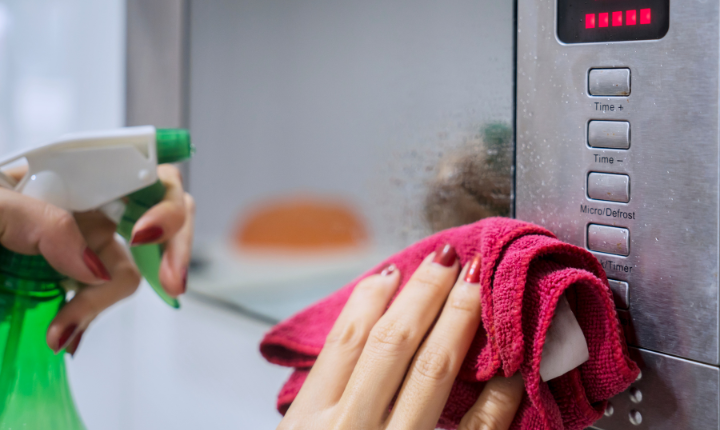The Ultimate Guide on How to Clean a Microwave. A microwave is a versatile and indispensable appliance in any kitchen, but it can accumulate dirt, grime, and food stains over time. Cleaning your microwave regularly ensures its longevity, keeps your food tasting fresh, and prevents any unpleasant odors. This comprehensive guide will walk you through the step-by-step process of deep cleaning your microwave, providing effective solutions and tips for a sparkling appliance.
Understanding The Importance of Regular Microwave Cleaning
Regular microwave cleaning is essential for maintaining a hygienic and efficient kitchen. However, over time, food particles, spills, and splatters can accumulate inside the microwave, creating a breeding ground for bacteria and unpleasant odors. Therefore, paying attention to the cleanliness of your microwave not only compromises the taste and quality of your food and poses potential health risks.
By understanding the importance of regular microwave cleaning, you can ensure that your meals are prepared in a clean environment, free from contaminants. Regular cleaning removes visible dirt and prevents the buildup of stubborn stains and grime, which can be challenging to remove later. Also, a clean microwave operates more efficiently, allowing for even and consistent heating, ultimately enhancing your overall cooking experience. So, take a proactive approach and prioritize regular microwave cleaning to maintain a healthy and pristine kitchen environment.
Preparing Your Microwave For Cleaning
Before diving into the cleaning process, properly preparing your microwave for a thorough cleaning session is crucial. Start by unplugging the appliance to ensure your safety throughout the process. Next, remove any loose items, such as turntable plates, racks, or microwave-safe containers. These removable parts can be cleaned separately to ensure a comprehensive microwave cleaning.
Inspect the interior for any visible debris or food residue, and use a damp cloth or sponge to wipe them away. Pay close attention to the corners, crevices, and the inner door, as these areas often accumulate the most grime. By preparing your microwave for cleaning, you’ll be setting the stage for a more effective and efficient cleaning process, leaving your appliance looking and functioning at its best.

Natural Cleaning Solutions For a Chemical-Free Approach
If you prefer a chemical-free approach to cleaning your microwave, several natural cleaning solutions can effectively tackle grime and stains. One popular option is using a mixture of vinegar and water. Combine equal parts of white vinegar and water in a microwave-safe bowl or cup, then place it inside the microwave. Heat the mixture on high for a few minutes until it steams. The steam will help loosen stubborn food residue and make it easier to wipe away. Another natural option is using lemon juice. Squeeze the juice of one lemon into a microwave-safe water bowl and heat it for a few minutes.
The acidic properties of lemon juice work wonders in cutting through grease and leaving a fresh scent. Baking soda is also a versatile natural cleaner. Create a paste by mixing baking soda with water, apply it to the interior surfaces of your microwave, and let it sit for a while. Then, scrub gently with a sponge or cloth to remove any grime. These natural cleaning solutions provide an eco-friendly alternative and leave your microwave sparkling clean without any harsh chemicals or strong odors.
Tackling Stubborn Stains And Food Residue
Stubborn stains and food residue can be challenging in your microwave, but with the right techniques, you can tackle them effectively. One method is using a mixture of dish soap and warm water. Create a soapy solution in a bowl and dip a sponge or cloth into it. Gently scrub the stained areas, focusing on the toughest spots. Rinse the sponge or cloth frequently and continue until the stains fade. You can create a paste for particularly stubborn stains by combining baking soda and water. Apply the paste to the affected areas and let it sit for a few minutes.
Then, gently scrub the paste in a circular motion using a damp cloth or sponge. This helps break down the stains and food residue, making them easier to remove. For tough, stuck-on food, you can also try heating a water bowl for a few minutes to create steam. The steam will help loosen the residue, allowing you to wipe it away easily. By employing these techniques and a little patience, you can effectively tackle stubborn stains and food residue, leaving your microwave fresh and clean.
Cleaning The Exterior of Your Microwave
While cleaning the interior of your microwave is essential, remember the exterior, as it contributes to the overall appearance of your kitchen. Prepare a mild cleaning solution using dish soap and warm water to clean the exterior. Dip a sponge or cloth into the solution, wring out the excess water, and gently wipe down the exterior surfaces of the microwave. Pay attention to areas prone to fingerprints and smudges, such as the control panel, handle, and buttons.
For stainless steel microwaves, consider using a specific stainless steel cleaner or a homemade vinegar and water solution to maintain their shine. Remember to avoid using abrasive cleaners or harsh chemicals that may damage the surface of your microwave. Also, remember to clean the vent openings and the backside of the microwave, as they can collect dust and debris over time. Once you’ve thoroughly wiped down the exterior, use a clean, dry cloth to buff and polish the surfaces, revealing a radiant and spotless microwave that complements your clean kitchen environment.
Maintenance Tips For a Clean And Fresh Microwave
Regular maintenance practices are key to ensuring a clean and fresh microwave beyond just the cleaning process. One important tip is to cover your food when heating it in the microwave. This prevents splatters and spills, reducing the chances of stains and residue buildup. Another maintenance practice is to wipe down the interior of your microwave after each use. A quick wipe with a damp cloth or sponge can remove minor spills or crumbs, preventing them from hardening or accumulating. It’s also beneficial to periodically inspect the microwave’s seal and door gasket for any signs of wear or damage.
A tight seal ensures optimal heating and prevents moisture or odors from escaping. Also, be mindful of what you place inside the microwave. For example, avoid using containers or utensils that can cause damage, such as those made of metal or with metallic accents. Lastly, consider placing a microwave-safe cover or bowl of water with a few drops of lemon juice inside the microwave and heating it for a few minutes. This helps eliminate any lingering odors and keeps your microwave smelling fresh. By following these maintenance tips, you can prolong the cleanliness and freshness of your microwave, ensuring a reliable and pleasant cooking experience for years to come.
Troubleshooting Common Microwave Cleaning Issues
While cleaning your microwave, you may encounter common issues that can be easily addressed. For example, one common problem is a lingering odor inside the microwave. To tackle this issue, wipe the interior with water and vinegar. Alternatively, you can place a microwave-safe bowl filled with water and a few slices of lemon or a tablespoon of baking soda inside the microwave and heat it for a few minutes to eliminate odors. Another issue is the presence of stubborn stains that refuse to come off. In such cases, create a paste using baking soda and water, apply it to the stains, and let it sit before scrubbing gently.
For greasy stains, dish soap mixed with warm water can effectively cut through the grease. In the event of a microwave interior that remains dirty despite cleaning efforts, check the manufacturer’s instructions for removable parts that may need to be cleaned separately. Also, it’s important to ensure the microwave is completely dry before using it again to prevent electrical issues. By troubleshooting these common cleaning issues with simple solutions, you can overcome obstacles and maintain a clean and functional microwave in your kitchen.
Safety Precautions To Keep In Mind
When cleaning your microwave, it is crucial to prioritize safety to prevent accidents or damage. Firstly, always unplug the microwave before beginning the cleaning process. This ensures you won’t accidentally turn it on or come into contact with any electrical components while cleaning. Also, avoid using harsh or abrasive cleaning agents that can damage the interior or exterior surfaces of the microwave. Instead, stick to mild cleaning solutions, such as dish soap and water, or natural alternatives, like vinegar and baking soda.
Remember to wear protective gloves to avoid skin irritation or potential exposure to cleaning chemicals. When cleaning the interior, be cautious of steam and hot surfaces. Allow the microwave to cool down if it was recently in use, and use caution when removing any hot water or cleaning solutions from inside the microwave. Lastly, follow the manufacturer’s instructions for cleaning and maintenance, as each microwave may have specific guidelines. By keeping these safety precautions in mind, you can ensure a safe and hassle-free cleaning experience while maintaining the longevity and functionality of your microwave.
Reviving The Shine: Additional Tips For a Sparkling Microwave
The essential cleaning steps, there are a few extra tips to revive the shine of your microwave and ensure it remains sparkling clean. One effective method is using a glass cleaner or a solution of equal parts vinegar and water to polish the window or glass door of the microwave. Spray the cleaner onto a microfiber cloth and gently wipe the glass surfaces in circular motions until they shine. Another tip is to use a toothbrush or a soft-bristle brush to clean hard-to-reach areas, such as the vents or the crevices around the control panel. Dip the brush in a cleaning solution and scrub gently to remove dirt or debris.
For a final touch, wipe down the exterior surfaces of the microwave with a dry microfiber cloth to remove any remaining streaks or watermarks, leaving a glossy finish. Next, place a microwave-safe bowl filled with water and a few drops of vanilla extract or lemon juice inside the microwave and heat it for a minute or two. This can leave a pleasant aroma and add a fresh touch to your sparkling microwave. By implementing these additional tips, you can take your microwave cleaning to the next level, ensuring that it looks clean and shines like new.
FINAL THOUGHT
By following the ultimate guide on cleaning a microwave, you can enjoy a clean and healthy microwave experience. Regular cleaning, both inside and outside the microwave, is crucial for maintaining a hygienic kitchen environment and ensuring the longevity of your appliance. Understanding the importance of regular microwave cleaning helps you prevent the buildup of dirt, grime, and bacteria that can affect the taste and quality of your food. Preparing your microwave for cleaning sets the stage for an effective and efficient cleaning process. Natural cleaning solutions provide a chemical-free approach to tackling dirt and stains, while specific techniques help you address stubborn stains and food residue.
Also, maintaining your microwave’s exterior contributes to your kitchen’s overall cleanliness and appearance. Furthermore, adhering to safety precautions, you can clean your microwave without any accidents or damage. Lastly, following additional tips for a sparkling microwave helps you revive its shine and maintain its cleanliness over time. So, take these guidelines to heart and enjoy the benefits of a clean and healthy microwave, ensuring a pleasant cooking experience and delicious meals every time.












Commented Posts